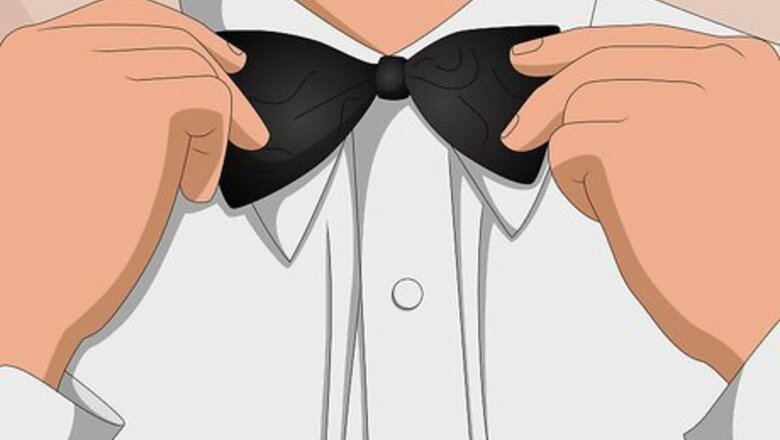
views
Looking the Part
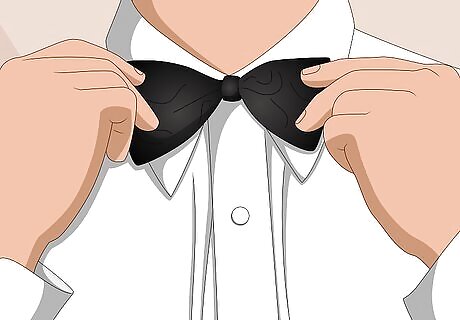
Figure out if “black tie” is right for you. Whether for a wedding, prom, or formal event, the tuxedo is a classic look that exudes style. The tux in its most basic form sports simple lines similar to a normal man's suit, but with the addition of silk bands on the outside hem of each trouser leg. The lapels on the jacket are also often fashioned with silk, helping to provide a more formal look. In the contemporary US, tuxedos are usually considered the “gold standard” for formal wear. It might surprise you, however, that tuxes – called black tie attire for the black bowtie – are neither the most formal in men’s dress wear nor always appropriate for important occasions.

Learn to tell the tuxedo apart from other forms of dress attire. Historically, there is a sort of hierarchy of menswear. Tuxedos actually grew out of was, for the time, relaxed evening wear as an alternative to the tailed frock coat. “Black tie,” then, is only one kind of “formal wear,” the other being the even more formal “white tie,” a similar outfit with white bowtie, tails, and often tophat. White tie attire is usually reserved for the most fancy or formal events, like debutante balls, state dinners, and galas. Keep in mind that black tie is also not “day wear.” According to tradition, events that occur during the evening call for either white or black tie, while daytime events call for day wear like morning dress or a man’s business suit. Morning suits are worn more often in Britain and feature a black or grey cutaway or morning coat, non-matching grey trousers—sometimes striped, buff waistcoat, tie, and often tophat. Morning suits also come in a hierarchy, from formal morning dress to less formal morning suit and even the semi-formal “stroller,” which has no tails.

Note the time of day. When will your upcoming event occur? In general if your event is during the daytime, you should go with day wear like a morning suit. If it is after dark, you are safe to go with black or white tie formal evening wear. The rule governing the proper forms of dress has to do with when the event ends. So, for example, if you are attending a wedding that starts during the day but ends after sundown, you can choose evening wear.
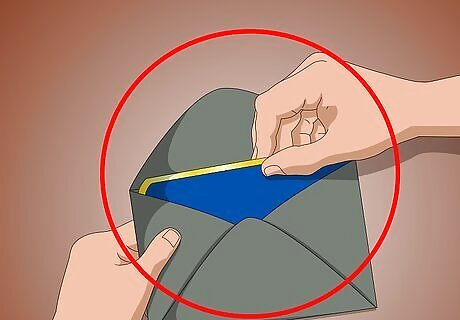
Check your invitation. Often event invitations will give instructions on dress. Pay close attention to the wording so that you can determine whether or not you will need a tuxedo. Parsing the language can sometimes take a bit of effort. For instance, an invitation calling for “formal wear” does not necessarily mean a tux. Formal wear refers to a complete suit – tie, cuff links, and the works – but, as noted, can also include white tie or morning wear. A black tie event means that you will be expected to wear a tux, so get ready for fittings. Showing up in anything else would be a faux pas. “Black tie optional” means just that – if you’d like, you can wear a tuxedo. “Semi-formal” is a notch down from formal, and means that tuxedos are not required. Here, you’d be better to settle on a dark suit for evening events.
Choosing Styles and Colors

Identify the most flattering style. When selecting a tuxedo, keep in mind that your physical build will have a big influence on what suit to choose. Getting a tux that fits you well is the most difficult and important part of looking great; an ill-fitting tux can make you look sloppy or crumpled. For instance, a double-breasted jacket will look better on men that are slim and somewhat tall, as the design adds some substance to his appearance. For men who are shorter or wider in the chest and stomach areas, a single-breasted tuxedo is usually a better option. A jacket design that includes peak lapels or a shawl collar is pretty timeless and will provide a sense of being stylish without being a slave to passing fads. Your jacket should only close on one button. Any more than that, and it begins to take on the appearance of a daytime suit, which is of course inappropriate for Black Tie.

Get a sharp jacket. As a rule, the tux jacket should fit much like a suit jacket: i.e. the ideal fit will be close but not pinch or restrict your movement. The back should cover your bottom to its lowest curve. The jacket shoulders should fit snugly with fairly high armholes. Shoulder padding should not extend past your shoulder tips, otherwise the jacket is likely too big. With arms at your sides, the arms of the jacket should cover your wrist bone. They should reveal no more than one half-inch of your shirt sleeves.
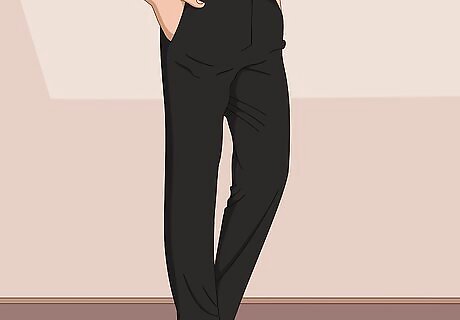
Pick well fitting trousers. Tuxedo trousers are fairly straightforward. They are black, made from the same material as the jacket, and have a single strip of satin or grosgrain down the outer leg called the “galon.” Choose trousers that are an exact color match with your jacket. Tuxedo trousers should be high-waisted so that there is not gap with whatever waist-covering you choose, either a waistcoat or cummerbund. They have no belt-loops but should either be worn with suspenders or fastened with clasps. The trousers should also have no cuffs. Some varieties come pleated, but many men feel that plain fronts provide a more elegant look.
Choose the color carefully. You might be tempted to stand out a bit with a colored tuxedo, but don't fall into this trap. The only traditional colors for a tuxedo are black, or midnight blue, which in darker lighting can appear "blacker than black." Other colors are acceptable for the jacket, but only if the rest of the ensemble is strictly classic. An off-white or ivory color jacket is a classic alternative that was immortalized by Humphrey Bogart in Casablanca. Unlike a colored suit, black or midnight blue will not look outdated after 10, 20, or 30 years. In general, most fashion experts warn against colored tuxedos as novelties. Think the blue and orange tuxes in “Dumb and Dumber.” The only exceptions to the color rule are midnight blue jacket and trousers, and an off-white jacket. Both are acceptable for formal events. Midnight blue is a dark navy blue that appears blacker than black in the night time. The white tuxedo is a difficult proposition. White tuxes began as a “warm weather” alternative to the heavier and hotter black tux. While some can pull off the look well, others, especially those with fair skin, look washed out. Still others feel that white tuxes make the wearer look like a waiter.
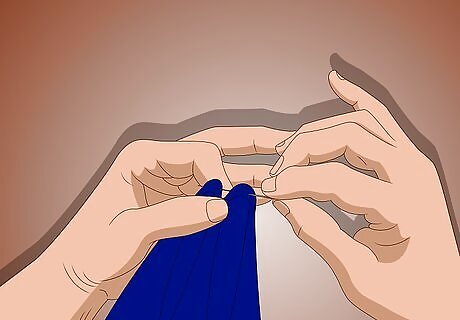
Have the tux tailored, if necessary. The most important part of selecting a tux is probably getting the shoulders right. The rest can be fairly cheaply altered by a tailor so that everything “pops” as it should, depending, again, on your body type. Many tuxes will need three basic alterations: shortened sleeves, tailored pants, and a “suppressed” waist—if it suits the wearer. Off-the-rack jackets often have sleeves that are too long. Tux pants, likewise, also normally run too long. You may need to get both shortened. Note that many fashionistas disapprove of cuffed tux pants. Waist “suppression” is a pinching off of the tux waist to accentuate the lines of your figure. Yes, men have figures – naturally “V-shaped” torsos. You don’t want the tux to give you a boxy look, so consider this alteration, if need be.
Choosing Accessories
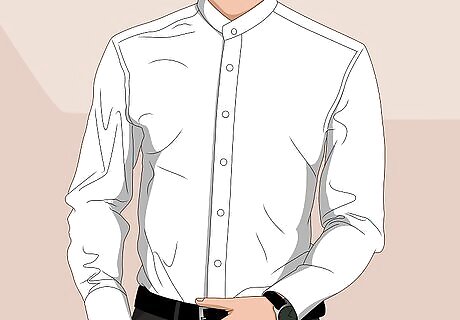
Find the right shirt. Getting the right shirt seems simple, no? After all, it’s just a shirt. You will be surprised at how much variety there are in tuxedo shirts, from collar to bosom and cuffs. Choose one that you like and that also goes well with your suit. Crisp white is the only option with any tuxedo, as it compliments almost any color of tuxedo. Tux shirts can have different kinds of collars. Wing collars are starched, high collars with small points that stick out under your chin. There are also normal turn-down collars, which are like the collars on a normal dress shirt. The wing collar is more formal, but it looks much better if the collar is of a taller variety. The bosom, or front, of the shirt is another site for choice. While some shirts are plain, others have vertical pleats and still others have piqué (known as Marcella in Europe), a special fabric that has a somewhat birdseye weave in the fabric. The bosom of a piqué shirt should be heavily starched. The shirt also has different options for fastening: you can use studs, or you can use the shirt's original buttons. The only time the original buttons should be used is if the buttons are Mother of Pearl, or if the shirt has a hidden fly, which is essentially an extra piece of cloth that covers the button placket. Studs are much more common, and you have many more options with studs. The two main ways to go with studs are to have black onyx surrounded by a gold or silver metal, or a Mother of Pearl stud, again set in a silver or a gold tone stud. Finally, there are cuffs. The two styles you have here are French Cuffs (also known as double cuffs) or barrel cuffs (also known as single cuffs). A good rule of thumb is that double cuffs should go with turndown collars, and single cuffs should go with wing collars. It should go without saying that cuffs should close with cufflinks.
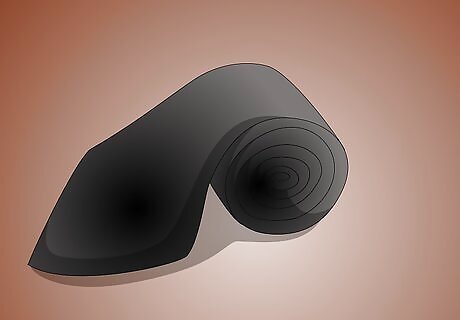
Choose a classic tie. Traditionally, tuxedos are worn with a black bow tie, however if everything else in the ensemble is classic, then midnight blue or sometimes maroon is a tasteful exception to the rule. Other tasteful exceptions include small white repeating patterns in the tie, such as white subtle polka dots, or a pattern in the weave of the fabric. Keep in mind too that bow ties come in a number of varieties and styles. These include butterfly bow ties, semi-butterfly, straightedge, and pointed. Clip -ons or pre-tied ties are convenient, but try to learn how to tie your own, especially if you go to formal occasions with some frequency. It looks much better, and at the end of the night, you can parade around with your bow tie untied and draped around your neck, much like a particularly well known spy in Hollywood.
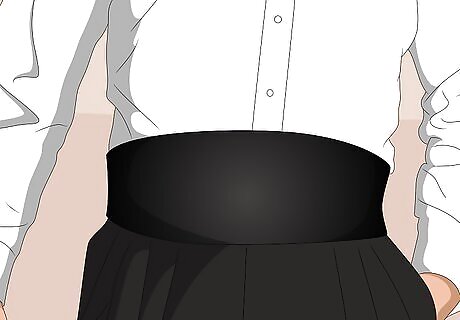
Cover your waist. Tuxedos are always worn with a waist covering, either a more traditional waistcoat or a cummerbund. These coverings should not be worn together. There are also some unspoken rules about how and when to wear them. The traditional waistcoat is the classic look, either in its single or double breasted forms, and differs somewhat in cut from the three-piece suit waistcoat. Namely, it is cut low and wide and has shawl lapels. Cummerbunds are pleated sashes that wrap around the waist and is usually made of the same silk fabric as the tux’s braid and lapel facings. The waist covering should conceal your waistband all the way around. Cummerbunds tend to look best when they are the same color as the whole ensemble. Avoid choosing a flashy color. In general, the fabric that makes up your cummerbund should be the same as your bow tie. Some purists match the cummerbund, tie, lapel facing, and trouser stripe. If all are black silk grosgrain, you can't go wrong.
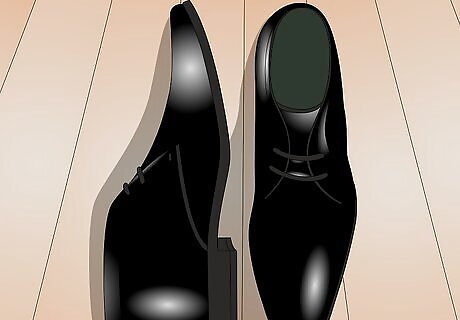
Keep the shoes simple. Choose a basic pair of lace-up patent leather shoes that are the same color as the trousers, jacket and socks. This approach helps to maintain the unified look from head to toe, preventing any sudden jarring lines. Formal “pumps” or “opera shoes” are an option. This shoes are made from highly polished patent leather and have either a pinched or flat bow on top. If one wishes, pumps made from velvet—with or without embroidery—may be used in lieu of a formal pump or oxford, but must only be worn by the host of a Black Tie event, if the event takes place in his own home. The only exception to this rule is if you go to a gentleman's club (that is truly that, a formal place for gentlemen to lounge and engage in political, social, or economical discourse). A simple pair of calf leather black cap toes or whole cuts shined to a beautiful luster are more than appropriate. Stay away from brogues, suede, boots, etc. These shoes can also be used for less formal events, so are a great choice if you're limited in your budget.
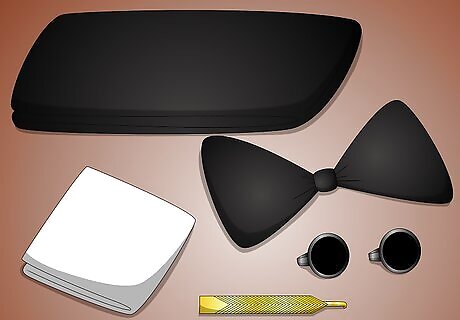
Add other accessories with care. Accentuating your outfit with a kerchief, pocket watch, or boutonniere can really make the tuxedo “pop” in all the right ways. Be mindful of what is considered acceptable, however, and try not to overdo it. Kerchiefs or pocket squares will look best in white, and preferably in linen or cotton. For black tie, you can wear either a wrist or pocket watch. Try to get one that matches the color of your button studs and cuff links, and keep the wristwatch conservative. There was a time when looking at your watch at an evening event was considered impolite, as it shows you have something more important waiting for you. If you opt for a wristwatch, make it conservative, and leave your big heavy diving watch with the pressure gauge at home. If you’d like to wear a hat, don’t go for the top hat – this is considered appropriate only for white tie attire. Go for a fedora or a homburg instead. When in doubt, choose accessories that are same color as the trousers and jacket.




















Comments
0 comment